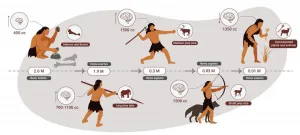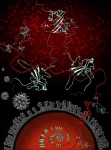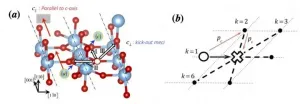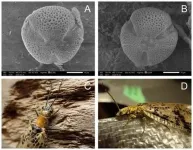Software package enables deeper understanding of cancer immune responses
Expands understanding of immune responses in cancer and other diseases
2021-04-05
(Press-News.org) Researchers at the Bloomberg~Kimmel Institute for Cancer Immunotherapy at the Johns Hopkins Kimmel Cancer Center have developed DeepTCR, a software package that employs deep-learning algorithms to analyze T-cell receptor (TCR) sequencing data. T-cell receptors are found on the surface of immune T cells. These receptors bind to certain antigens, or proteins, found on abnormal cells, such as cancer cells and cells infected with a virus or bacteria, to guide the T cells to attack and destroy the affected cells.
"DeepTCR is an open-source software that can be used to answer questions in research into infectious disease, cancer immunology and autoimmune disease; any place where the immune system has a role through its T-cell receptors," said lead study author John-William Sidhom, an M.D./Ph.D. student at the Johns Hopkins University School of Medicine and Department of Biomedical Engineering working in the Bloomberg~Kimmel Institute for Cancer Immunotherapy.
The research was published March 11 in Nature Communications.
Sidhom was inspired to develop the software after attending a presentation on the use of deep learning for the medical sciences at the 2017 meeting of the American Association for Cancer Research. "I was doing research on T-cell receptor sequencing, and it struck me that this was the right technology to better analyze T-cell sequencing data," he says.
Deep learning is a form of artificial intelligence that roughly mimics the workings of the human brain in terms of pattern recognition. "Deep learning is a very flexible and powerful way to do pattern recognition on any kind of data. In this paper, we use deep learning to identify patterns in sequencing data of the T-cell receptor," says Sidhom, adding that the way the software explores T-cell receptors is analogous to an internet search. "When someone performs an internet search for an image of cats or dogs, the query doesn't involve looking for images that have a caption that labels the image as a cat or dog, but rather applies an algorithm that explores the features of the images and recognizes patterns that identify the images as a cat or dog. This is deep learning."
DeepTCR is a comprehensive deep-learning framework that includes both unsupervised and supervised deep learning models that can be applied at the sequence and sample level. Sidhom says the unsupervised approaches allow investigators to analyze their data in an exploratory fashion, where there may not be known immune exposures, and the supervised approaches will allow investigators to leverage known exposures to improve the learning of the models. As a result, he says, DeepTCR will enable investigators to study the function of the T-cell immune response in basic and clinical sciences by identifying the patterns in the receptors that confer the function of the T cell to recognize and kill pathological cells.
One of the main challenges of analyzing TCR sequencing data is distinguishing meaningful sequencing data from inconsequential data, and DeepTCR helps perform this analysis. "There are a lot of sequences in someone's immune repertoire. There are a lot of pathogens that someone can be infected by, so the immune response is very broad. As a result, there is a sea of noise in the immune response, and only parts of it are important at a certain time for a certain infection," Sidhom explains. "I may have T-cell responses to a thousand different viruses, but when the flu impacts me, I only need to utilize a small subset of those T cells to fight the flu. The main thing that the algorithm can do is isolate and match the right T cells to specific responses."
The software package, which employs a type of deep-learning architecture called a convolutional neural network, provides users the ability to find T-cell sequencing patterns that are relevant to a specific exposure, like a flu infection, a cancer or an autoimmune disease.
"When presented with a lot of data, our algorithms can learn rules of these TCR sequence patterns. For example, we may not know the rules for how the body responds to flu, but with enough data, our software can learn those rules and then teach us what they are," says Sidhom. "It is very well-suited to identify complex patterns in a very, very large immune repertoire to identify the interacting partners between a T-cell receptor and its antigen."
INFORMATION:
In addition to Sidhom, others participating in the research were H. Benjamin Larman, Drew M. Pardoll and Alexander S. Baras.
The research was supported by the Bloomberg~Kimmel Institute for Cancer Immunotherapy, the Mark Foundation for Cancer Research, philanthropy of Susan Wojcicki and Dennis Troper in support of Computational Pathology at Johns Hopkins, the Johns Hopkins-Bristol-Myers Squibb Immuno-Oncology Consortium, and the National Institutes of Health Cancer Center Support Grant.
Full Article
ELSE PRESS RELEASES FROM THIS DATE:
2021-04-05
A research team led by Professor PAN Jianwei and Professor XU Feihu from University of Science and Technology of China achieved single-photon 3D imaging over 200 km using high-efficiency optical devices and a new noise-suppression technique, which is commented by the reviewer as an almost "heroic" attempt at single photon lidar imaging at very long distances.
Lidar imaging technology has enabled high precision 3D imaging of target scene in recent year. Single photon imaging lidar is an ideal technology for remote optical imaging with single-photon level sensitivity and picosecond resolution, yet its imaging range is strictly limited by the quadratically decreasing count of photons that echo back.
Researchers first optimized transceiver optics. The lidar system setup adopted ...
2021-04-05
A new automated process prints a peptide-based hydrogel scaffold containing uniformly distributed cells. The scaffolds hold their shapes well and successfully facilitate cell growth that lasts for weeks.
"Bioprinting" -- 3D printing that incorporates living cells -- has the potential to revolutionize tissue engineering and regenerative medicine. Scientists have experimented with natural and synthetic "bioinks" to print out scaffolds that hold cells in place as they grow and form a tissue with a specific shape. But there are challenges with cell survival. Natural bioinks, such as gelatin and collagen, need to be treated with chemicals or ultraviolet light to hold their shape, which affects ...
2021-04-05
A new analysis of the entire genetic makeup of more than 53,000 people offers a bonanza of valuable insights into heart, lung, blood and sleep disorders, paving the way for new and better ways to treat and prevent some of the most common causes of disability and death.
The analysis from the Trans-Omics for Precision Medicine (TOPMed) program examines the complete genomes of 53,831 people of diverse backgrounds on different continents. Most are from minority groups, which have been historically underrepresented in genetic studies. The increased representation should translate into better understanding of how heart, lung, blood and sleep disorders affect minorities and should help reduce longstanding health disparities.
"The Human Genome Project has generated ...
2021-04-05
Researchers at Tel Aviv University were able to reconstruct the nutrition of stone age humans. In a paper published in the Yearbook of the American Physical Anthropology Association, Dr. Miki Ben-Dor and Prof. Ran Barkai of the Jacob M. Alkov Department of Archaeology at Tel Aviv University, together with Raphael Sirtoli of Portugal, show that humans were an apex predator for about two million years. Only the extinction of larger animals (megafauna) in various parts of the world, and the decline of animal food sources toward the end of the stone age, led humans to gradually increase the vegetable element in their nutrition, until finally they had no choice but to domesticate both plants and animals - and became farmers.
"So far, attempts to reconstruct the diet of stone-age humans ...
2021-04-05
WASHINGTON, April 5, 2021 -- Forever chemicals are known for being water-, heat- and oil-resistant, which makes them useful in everything from rain jackets to firefighting foams. But the chemistry that makes them so useful also makes them stick around in the environment and in us -- and that could be a bad thing: https://youtu.be/tqKEG5LxPiY.
INFORMATION:
Reactions is a video series produced by the American Chemical Society and PBS Digital Studios. Subscribe to Reactions at http://bit.ly/ACSReactions and follow us on Twitter @ACSReactions.
The American Chemical Society (ACS) is a nonprofit organization chartered by the U.S. Congress. ACS' mission is to advance the broader ...
2021-04-05
CORVALLIS, Ore. - Researchers in the Oregon State University College of Science have taken a key step toward new drugs and vaccines for combating COVID-19 with a deep dive into one protein's interactions with SARS-CoV-2 genetic material.
The virus' nucleocapsid protein, or N protein, is a prime target for disease-fighting interventions because of the critical jobs it performs for the novel coronavirus' infection cycle and because it mutates at a comparatively slow pace. Drugs and vaccines built around the work of the N protein carry the potential to be highly effective and for longer periods of time - i.e., less susceptible to resistance.
Among the SARS-CoV-2 proteins, ...
2021-04-05
Ishikawa, Japan - One of the most important classes of problems that all scientists and mathematicians aspire to solve, due to their relevance in both science and real life, are optimization problems. From esoteric computer science puzzles to the more realistic problems of vehicle routing, investment portfolio design, and digital marketing--at the heart of it all lies an optimization problem that needs to be solved.
An appealing technique often used in solving such problems is the technique of "quantum annealing", a framework that tackles optimization problems by using "quantum tunneling"--a quantum physical phenomenon--to pick out an optimum solution out of several candidate solutions. ...
2021-04-05
INDIANAPOLIS -- The high incidence of COVID-19 and resulting sudden changes in the health of many long-stay nursing home residents across the country have amplified the importance of advance care planning and the need for periodic review of the process, especially as widespread vaccination changes the calculus of the disease.
Two new studies from Indiana University and Regenstrief Institute focus on POLST, a medical order form widely used in nursing homes that documents what life-sustaining treatments a person prefers to receive or not receive, such as hospitalization or comfort-focused care. The studies, published online ...
2021-04-05
Researchers from Kumamoto University (Japan) have found that adult nocturnal fishflies (Neochauliodes amamioshimanus), which are typically aquatic insects, feed on pollen at night. They also present circumstantial evidence suggesting that this species not only forages in flowers, but is also a supplementary pollinator. Their work sheds light on the terrestrial life of adult fishflies, which has been a mystery until now.
Megaloptera is a small taxon (about 400 species worldwide) consisting of the families Sialidae (alderflies) and Corydalidae (dobsonflies and fishflies), and is considered to be one of the oldest groups of insects that undergo complete metamorphosis. The biology of the fishfly's aquatic larvae, which were sometimes used as folk remedies in Japan, is relatively well understood. ...
2021-04-05
WASHINGTON, April 5, 2021 -- As the world awaits the upcoming Olympic games, a new method for detecting doping compounds in urine samples could level the playing field for those trying to keep athletics clean. Today, scientists report an approach using ion mobility-mass spectrometry to help regulatory agencies detect existing dopants and future "designer" compounds.
The researchers will present their results today at the spring meeting of the American Chemical Society (ACS). ACS Spring 2021 is being held online April 5-30. Live sessions will be hosted April 5-16, and on-demand and networking content will continue through April 30. The meeting features nearly 9,000 presentations ...
LAST 30 PRESS RELEASES:
[Press-News.org] Software package enables deeper understanding of cancer immune responses
Expands understanding of immune responses in cancer and other diseases







